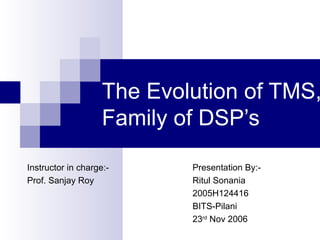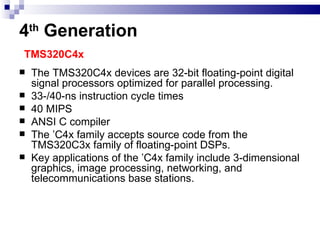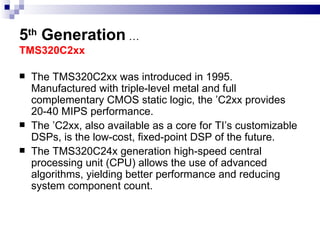The evolution of TMS, family of DSP\'s
- 1. The Evolution of TMS, Family of DSPŌĆÖs Presentation By:- Ritul Sonania 2005H124416 BITS-Pilani 23 rd Nov 2006 Instructor in charge:- Prof. Sanjay Roy
- 2. Outline DSP Introduction DSP Tasks DSP Applications DSP vs. General Purpose MPU TMS DSP IC TMS DSP Types TMS Generations Conclusion
- 3. DSP Introduction Digital Signal Processing : application of mathematical operations to digitally represented signals Signals represented digitally as sequences of samples . Digital Signal Processor (DSP) : electronic system that processes digital signals
- 4. DSP tasks- Most DSP tasks require: Repetitive numeric computations Real-time processing High memory System Flexibility DSPs must perform these tasks efficiently while minimizing: Cost Power Memory use Development time
- 5. DSP Applications Digital cellular phones Digital cameras Satellite communication Voice mail Music synthesis Modems RADAR
- 6. DSP vs. General Purpose MPU DSPs tend to be written for 1 program, not many programs. Hence OSes are much simpler, there is no virtual memory DSPs run real-time apps You must account for anything that could happen in a time slot All possible interrupts or exceptions must be noticed. DSPs have an infinite continuous data stream
- 7. TMS DSP IC.. TMS 320 C5X TMX : Experimental device TMP : Prototype TMS : Qualified device C: CMOS Tech with on ŌĆō chip non- volatile memory as ROM E: CMOS tech with on-chip non ŌĆō volatile memory as EPROM nothing : NMOS tech with on-chip non ŌĆō volatile mem as ROM 5 : Generation X : Version number- 0,1,2,3,4x,5,6,7
- 8. TMS DSP TypesŌĆ” Fixed Point DSPs TMS320C5x & 54x 16-bit DSPs Floating Point DSPs TMS320C3x, 4x & 6x 16 & 32-bit DSPs Multiprocessor DSPs TMS320C8x
- 10. BASIC TMS320 ARCHITECTURE A DSP has to perform fast arithmetic operations and should handle mathematical intensive algorithms in real time. This was achieved by these basic concepts- Harvard architecture ( increased memory access/cycle) extensive pipelining, dedicated hardware multiplier, special DSP instructions( DMOV ŌĆō delay) fast instruction cycle
- 11. 1 st Generation TMS320C1x Instruction cycle timing: -160 ns -200 ns -280 ns. 5 MIPS 20 MHz On chip data RAM: -144 words -256 words (TMS320C17). On chip program ROM: -1.5K words 4 K words (TMS320C17). 4K words of on chip program EPROM( TMS320E17). 16 x I6 bit multiplier with 32-bit result. 16-bit barrel shifter for shifting data memory words into the ALU. 4 x 12-bit stack. Two auxiliary registers for indirect addressing. Eight 16 bit I/O port Operating Temperature . . . 0┬░C to 70┬░C
- 12. 2 nd Generation TMS320C2x Reduced Instruction cycle timing: -100 ns (TMS320C25) 10 MIPS, 40 MHz 4K words of onchip masked ROM (TMS320C25). 544 words of onchip data RAM. 128K words of total program data memory space. Eight auxiliary registers with a dedicated arithmetic unit. Serial port for multiprocessing or interfacing to codecs. Bit-reversed addressing modes for fast Fourier trans-forms (TMS320C25). Extended-precision arithmetic and adaptive filtering support (TMS320C25).
- 13. 3 rd Generation TMS320C3x 60-ns single cycle execution time 20 -30 MIPS Two 1K x 32-bit single cycle dual-access RAM blocks. One 4K x 32-bit single cycle dual-access ROM block. 64 X 32-bit instruction cache. 32-bit instruction and data words, 24-bit addresses. 32*32 bit floating-point and integer multiplier ( 40 bit product ). 32-bit floating-point, integer, and logical ALU. 32-bit barrel shifter. Eight extended-precision registers. Two address-generators with eight auxiliary registers. On chip Direct Memory Access (DMA) controller. High-level language support.
- 14. 4 th Generation TMS320C4x The TMS320C4x devices are 32-bit floating-point digital signal processors optimized for parallel processing. 33-/40-ns instruction cycle times 40 MIPS ANSI C compiler The ŌĆÖC4x family accepts source code from the TMS320C3x family of floating-point DSPs. Key applications of the ŌĆÖC4x family include 3-dimensional graphics, image processing, networking, and telecommunications base stations.
- 15. 5 th Generation TMS320C5x Fixed Point DSP Power Efficient (1.15mA/MIPS) 20-50 MIPS 20-35ns single cycle execution time Bit reversed /index addressing mode for FFT Power Down modes 8 Auxiliary registers Single Cycle 16*16 bit parallel multiplier (32 bit product) 32 bit accumulator ,32 bit ALU
- 16. TMS320C54x 16-bit fixed point Power < 40 mW 300 to 532 MIPS 3 Power down modes RAM 16 Kb to 1280Kb(TMS320C5441-175) ROM max 256KB Applications ŌĆō Digital Cellular Base stations PDAŌĆÖs Digital Cordless Phones Modems
- 17. TMS320C55x 16 & 32 bit fixed point Most power efficient in the industry with 0.12mW (stand by) 600 MIPS Dual Processor RAM 320Kb ROM 32 to 64Kb Newest in series TMSC5506-108 Applications ŌĆō 2G,2.5G,3G cellular phones and base stations Digital audio players Digital still cameras GPS receivers Wireless modems
- 18. 5 th Generation ŌĆ” TMS320C2xx The TMS320C2xx was introduced in 1995. Manufactured with triple-level metal and full complementary CMOS static logic, the ŌĆÖC2xx provides 20-40 MIPS performance. The ŌĆÖC2xx, also available as a core for TIŌĆÖs customizable DSPs, is the low-cost, fixed-point DSP of the future. The TMS320C24x generation high-speed central processing unit (CPU) allows the use of advanced algorithms, yielding better performance and reducing system component count.
- 19. 5 th Generation .... TMS320C8x (1995) 1 Master Processor and up to 4 parallel processors More than 2 billion operations per second (BOPS) 50K bytes of on-chip RAM Video controller supports any display or capture resolution 32 bit RISC master processor with 120-MFLOPS Applications ŌĆō Desktop video conferencing, high-speed telecom, 3-dimensional and virtual reality graphics, digital audio and video compression .
- 20. 6 th Generation TMS320C6x First to feature VelociTI architecture . TMS320C62X multi-channel, multi-function applications Advanced VLIW architecture Medical, industrial applications, digital imaging, 3D graphics, speech recognition and voice-over packet. Frequency 150 to 300 MHz RAM up to 1 MB (min 128Kb) Greater than 1600 MIPS
- 21. 6 th Generation ... TMS320C6x TMS320C64x (highest level of performance ) Speeds up to 1GHz Up to 8000 MIPS digital communications infrastructure video and image processing TMS320C67x (high-precision applications ) First floating point processor in 6x series 6 ns cycle timing 1billion floating point operations per second (Flops) audio, medical imaging, instrumentation and automotive.
- 22. Comparison of various generations
- 23. Compariso n on the basis of clock frequency
- 24. Conclusion DSP performance has increased according to the applications involved. DSP friendly ness is an important factor because the applications complexity is increasing.
- 25. References http://www.ti.com http://www.bdti.com ŌĆ£ DSP Architectures: Past, Present and FutureŌĆØ, Edwin J. Tan, Wendi B. Heinzelman ŌĆ£ The TMS320 Family of Digital Signal ProcessorsŌĆØ, KUN SHAN LIN, GENE A. FRANTZ and RAY KUMAR,IEEE-1987
























